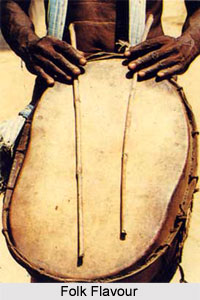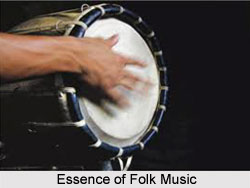 History of Indian folk music has a unique tale to tell as, it has, over the years, developed an elaborate flexible melodic character. From one end to the other, it has influenced the music of the common man of India. Despite the fact that India is home to variety of races with diverse musical traditions, a uniform cultural mode of expression of monolithic character can be discerned among the population. Folk-music is a part and parcel of this system.
History of Indian folk music has a unique tale to tell as, it has, over the years, developed an elaborate flexible melodic character. From one end to the other, it has influenced the music of the common man of India. Despite the fact that India is home to variety of races with diverse musical traditions, a uniform cultural mode of expression of monolithic character can be discerned among the population. Folk-music is a part and parcel of this system.
Folk-music of India adheres to monophonic structural system. According to scales of modern raga modes, the classification of music will prove more suitable. Ancient music and folk-music are based on their respective techniques, derived from elementary methods of formative processes of the general system easily explainable through Indian musicological principles. It is true that connecting links between folk-tunes and ragas have not been properly established as yet. And these features are important facets of this discipline.
But it can be seen that the folk-music of West Bengal and adjacent Indian states actually belongs to the same stock as is in vogue in other parts of the country, having originated somewhere at a certain stage and hybridized and developed later. They are akin to the basic system and are understandable by application of the same basic principles.
 As per legends, folk-lore in India has its primordial source in the Vedic literature, so also has the folk-music Folk-ballads of the Rig Veda. Vedic gathas in the Satapatha Brahmana and Aitareya Brahmana are the earliest specimens of marriage songs, the types of which were used by folk people. All this information dates back to 1500-500 B.C. No direct information about primitive music and folk-music is normally available. In the Vedic age, the people of the higher society endeavoured to tame Asuras-Raksasas, and divert their attention to their own. These are but general ideas about conversion of folk and local tunes into standard music.
As per legends, folk-lore in India has its primordial source in the Vedic literature, so also has the folk-music Folk-ballads of the Rig Veda. Vedic gathas in the Satapatha Brahmana and Aitareya Brahmana are the earliest specimens of marriage songs, the types of which were used by folk people. All this information dates back to 1500-500 B.C. No direct information about primitive music and folk-music is normally available. In the Vedic age, the people of the higher society endeavoured to tame Asuras-Raksasas, and divert their attention to their own. These are but general ideas about conversion of folk and local tunes into standard music.
There are some of the local folk tunes that have been turned into ragas, and most of these ragas have been named after countries, people or tribes from which the tunes have been collected. Evolved either from the tribes or from the people of different regions, the ragas are: malava-kaisika (raga malkauns) or maluh derived from Malav/Malaya/Malla, Takka or Tanka from the Takka tribe of Taxila, saka (Saka/Sakatilaka) from the Kushanas art, Pulindi from the Pulindi tribe, ahiri from Ahira tribe, bangal from Bengalis, andheri from Andhrades, bhotta originating from Bhottades or Tibet, gurjari from the Gujarat; bhairabi from Bhiraba tribe and so on. Eventually, however, many names appeared which prove how folk-tunes of different lands and music of different tribes have been incorporated and formulated as ragas. This process continued for a long period through different ages.
The history of ragas can be traced down to middle ages, fifteen hundred years back from the present century. During the course of its development for all these years the raga music, which is the Indian official music, has undergone a series of structural changes, and its current form is not more than six hundred years old. The continuous incorporation of several tribal and folk musical forms in its list has been a striking feature. When folk-music took a natural shape in the practical field, Indian musicologists started talking about reformed local melodies.




